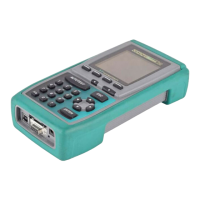6 - 3
OMNIScanner User Guide
SPLIT PAIRS:
If a cable is wired correctly, pin-to-pin, but there is a
split pair, Wiremap displays Split Pairs and highlights
the pins in error.
In our example, one wire from the 4-5 pair is twisted
with one wire in the 7-8 pair. The Split Pair will be
highlighted with reversed numbers.
The message SPLIT PAIRS will be displayed below
the Wiremap.
Press ESC to exit the WIREMAP screen.
TDNXT
NEXT faults are diagnosed by using the TDNXT (Time Domain NEXT)
function. OMNI
Scanner
uses TDNXT to determine the amount of NEXT as
a function of distance. TDNXT with new S-Band™ technology (Standard
Connector Band technology) can help you distinguish between connection
and cable faults. It assists you with diagnosis and troubleshooting of NEXT
failures and the verification of test cables, connectors and plugs.
While the NEXT graph shows the link test limits and the frequency at which
a failure occurred, the TDNXT graph displays NEXT vs. distance.
S-Bands™ provide a time domain limit to verify that the connections are
within the desired category of performance. In a typical link, failures are a
result of either a non-compliant connection or a faulty cable. The ability to
determine if a connection meets the expected performance requirement
significantly simplifies the diagnosis of a failure.
To diagnose a failure, select TDNXT in the DIAG-
NOSTICS screen and press ENTER. The TDNXT
function is also available from the NEXT Graph
screen.
The SELECT PAIRS screen opens.
Use the (Pair) function key to select the pairs
you want to analyze.

